Ceramic Tiles Market by Type (Porcelain, Glazed, Unglazed), Application (Floor Tiles, Internal Wall Tiles, External Wall Tiles) End-use Sector (Residential, Non-residential), Finish (Matt, Gloss), Construction Type, and Region - Global Forecast to 2027
Ceramic Tiles Market Overview
The global ceramic tiles market size was valued at USD 227.9 billion in 2022 and is projected to reach USD 320.5 billion by 2027, growing at 7.1% cagr during the forecast period. Ceramic tiles are a combination of clays and other organic substances like sand, quartz, and water. They are generally utilized as bathroom walls and kitchen floor surfaces in homes, businesses, restaurants, and other establishments. They come in a variety of styles and are simple to install, clean, and maintain. They are used in residential and non-residential sectors in the building & construction industry. The main purpose of ceramic tiles is to cater to the aesthetic need of buildings. Ceiling tiles are available in various types, such as porcelain, glazed, and unglazed.
Attractive Opportunities in the Ceramic Tiles Market
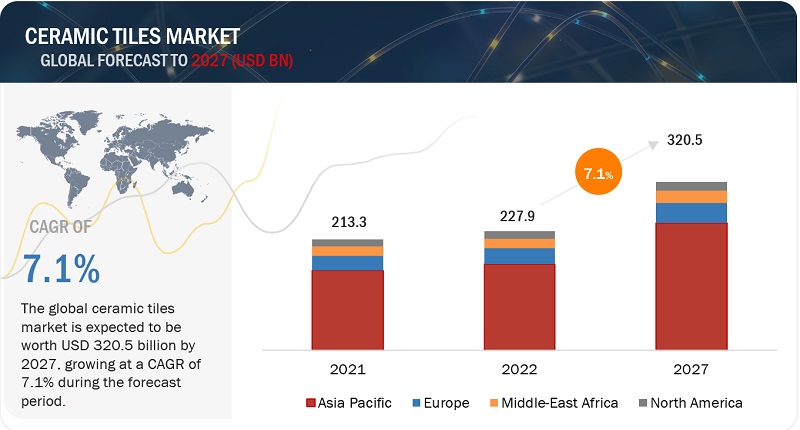
To know about the assumptions considered for the study, Request for Free Sample Report
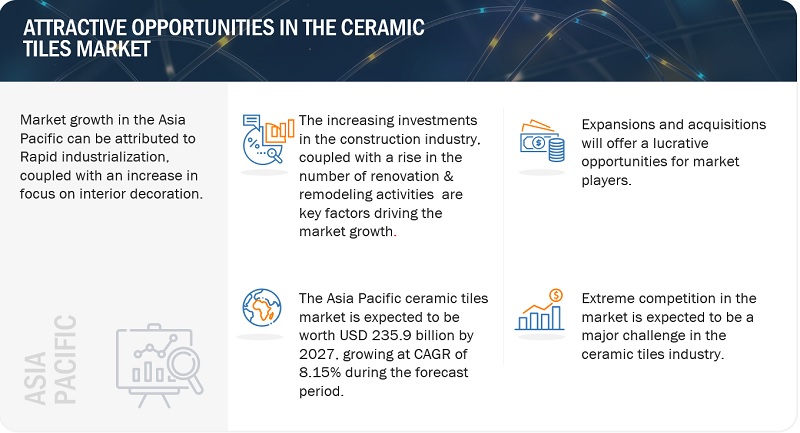
Ceramic Tiles Market Dynamics
Driver: Growing investment in the construction industry will drive the market.
Infrastructure spending is a key driver of global and regional economies. It is expected that spending on capital projects and infrastructure will grow significantly in the next decade. The US, China, Japan, Germany, Australia, Canada, India, Indonesia, Brazil, and Spain are investing large amounts in the construction industry, with the aim of achieving rapid and sustained economic growth. Sufficient infrastructure investment is required for the modernization and commercialization of economic activities. Rapid urbanization in emerging markets, such as China, India, Brazil, Malaysia, and Indonesia, further boosts spending in vital infrastructure sectors, such as hospitality, health care, retail, and transportation. Increasing prosperity in emerging markets is expected to drive the ceramic tiles industry. The table below depicts the value added in USD million for industry, including construction.
Restraint: Increasing regulations, requirements, and tariffs
Requirements in the UK and the EU are set by the norm EN 14411 (based on the international standard ISO 13006), whereas in the US, it is the ANSI 137. These standards categorize, define, and classify ceramic tiles into groups. Each group has defined values for chemical resistance, stain resistance, dimension, breaking strength, water absorption, surface abrasion, cracking resistance, and anti-slip properties. The values that the tiles have to meet and the test methods of each defined group are set by the norm. The European regulations divide ceramic tiles into various classes, laying down the characteristics to be controlled and the tolerances for each. The limits of some characteristics have not been defined and are the result of the agreement between the manufacturer and purchaser.
Opportunities: Increase in demand from emerging economies
Rapid industrialization; favorable government policies in emerging countries, such as China, India, and Russia; expanding foreign investments, increasing disposable income, and growing focus on interior decoration have resulted in the growth of the construction industry, which, in turn, drives the demand for ceramic tiles from emerging economies. The economic growth of China is stimulating the real estate market and the demand for floor-covering products. According to the International Trade Administration, China is the largest construction market globally. Similarly, in India, the growth in the construction industry continues to be strong, backed by favorable government policies, foreign direct investment (FDI) in the construction development sector, and an increasing population. These factors are expected to boost the domestic construction sector, which, in turn, will propel the demand for ceramic tile products from this emerging economy.
Challenges: Extremely competitive market
Highly competitive markets are those where many similar products or services are being offered by multiple businesses. The ceramic tiles business market is extremely competitive. The porcelain tiles market has a presence of many global and regional players. One of the major challenges is the determination of competitive pricing and the right price point. It gets difficult for operating players to retain a balance between offering low prices to attract customers and maintaining profitability. The difficulty lies in keeping prices lower than competitors for long enough to gain an advantage without sacrificing profitability.
Ceramic Tiles Market Ecosystem
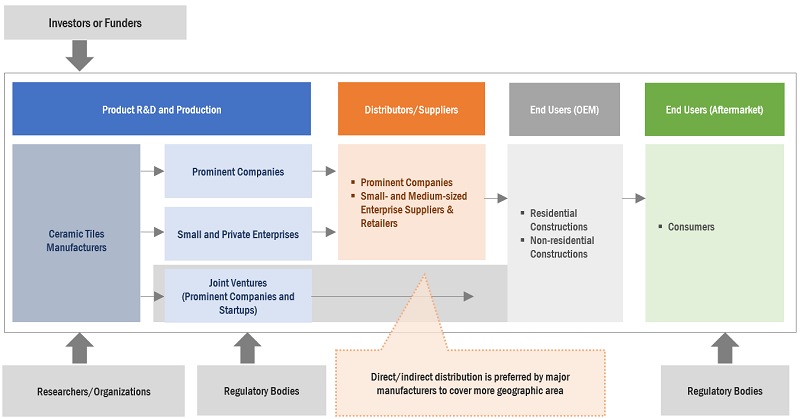
By End Use Sector, the residential segment accounted for the highest CAGR during the forecast period
The residential segment led the market for ceramic tiles, with a highest share of the overall market, in terms of value, in 2021. A rise in the number of new constructions and housing renovation & remodeling activities and an increase in disposable income levels are the key factors propelling the growth of the ceramic tiles market in the residential sector. Ceramic tiles are widely used in the residential segment for their durability and easy maintenance. The best option for flooring in areas such as kitchens, bathrooms, living rooms, dining spaces, and bedrooms is ceramic tiles. Housing renovation and maintenance have increased steadily in the recent past and are expected to increase further in the next few years, owing to the increasing disposable income of people.
By Type, the Porcelain segment accounted for the highest CAGR during the forecast period
The porcelain segment led the market for ceramic tiles, with a highest share of the overall market, in terms of value, in 2021, and is expected to grow at the highest CAGR from 2022 to 2027. The demand for porcelain tiles in recent years has been increasing due to their properties, such as low water absorption, slip resistance, and anti-bacterial properties. Owing to these properties, porcelain tiles are highly popular for both residential and commercial buildings. Porcelain tiles are of different types, such as glazed porcelain tiles, unglazed porcelain tiles, and full-body porcelain tiles, which are mainly used in the heavy-duty flooring application. Unglazed porcelain tile is made of uniform color and has a through-body composition which means little chips might not be as noticeable as they would be on a ceramic tile.
Asia Pacific is projected to account for the highest CAGR in the ceramic tiles market during the forecast period
The ceramic tiles market in the Asia Pacific region has exhibited the fastest growth. The region includes countries such as India, China, Vietnam, Indonesia, and the Rest of Asia Pacific. The ceramic tile market in countries like India, China, and Vietnam is expected to experience significant growth due to increasing building & construction activities, especially in China and India, coupled with increasing investments from domestic and foreign investors in the public and private sectors. Moreover, the region's growing population presents a vast customer base for ceramic tiles in the construction, which is expected to drive growth in the ceramic tile market.
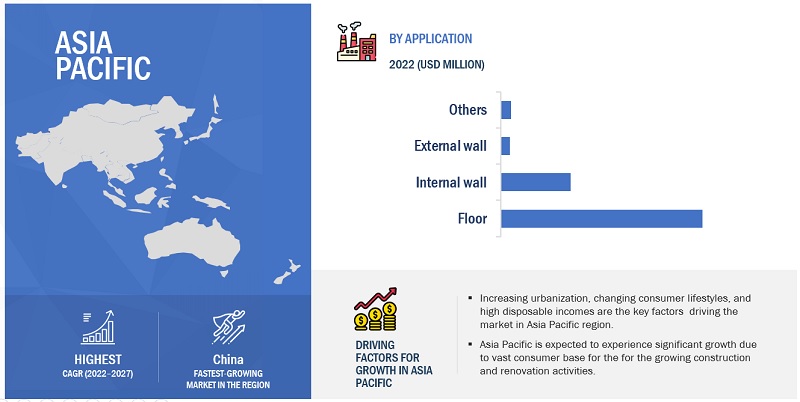
To know about the assumptions considered for the study, download the pdf brochure
By Application, the Floor Tiles segment accounted for the highest growth during the forecast period
Ceramic tiles are the best option for flooring material because of their strength, water resistance, and low maintenance. They also possess reliability and high durability. They find applications in healthcare centers, government offices, and sports institutes, where the expected footfall is high, as well as in residential buildings. These are best used on kitchen and bathroom floors as they are water-resistant and easy to clean. Ceramic tiles are available in various sizes, colors, shapes, and textures, which allows consumers to select according to their needs, therefore serving both functionally and aesthetically. New residential construction and commercial projects are increasingly adopting ceramic tiles as flooring solutions as they enhance the aesthetic appeal and are cost-efficient, durable, low-maintenance, and moisture-resistant.
Ceramic Tiles Market Players
Ceramic tiles comprises major manufacturers such as RAK Ceramics (UAE), SCG Ceramics (Thailand), Mohawk Industries Inc. (US), Grupo Lamosa (Mexico), and Kajaria Ceramics (India) were the leading players in the ceramic tiles market. Expansions, acquisitions, joint ventures, and new product developments are some of the major strategies adopted by these key players to enhance their positions in the ceramic tiles market. Mohawk Industries Inc. is one of the leading players in the United States ceramic tile market.
Ceramic Tiles Market Report Scope
|
Report Metric |
Details |
|
Market Size Value in 2022 |
USD 227.9 billion |
|
Revenue Forecast in 2027 |
USD 320.5 billion |
|
CAGR |
7.1% |
|
Years Considered |
2020–2027 |
|
Base year |
2021 |
|
Forecast period |
2022–2027 |
|
Unit considered |
Value (USD Billion), and Volume (Million Square Meters) |
|
Segments |
Type, Application, End-use sector, Finish, Construction Type, and Region |
|
Regions |
Asia Pacific, Europe, North America, Middle East & Africa, South America, and Oceania. |
|
Companies |
The major players are Mohawk Industries Inc. (US), Grupo Lamosa (Mexico), RAK Ceramics (UAE), SCG Ceramics (Thailand), and Kajaria Ceramics (India) and others are covered in the Ceramic Tiles market. |
This research report categorizes the global Ceramic Tiles market on the basis of Type, Application, End-use sector, Finish, Construction Type, and Region.
Ceramic Tiles Market by Type
- Porcelain
- Glazed
- Unglazed
Ceramic Tiles Market by Application
- Floor
- Internal Wall
- External Wall
- Others
Ceramic Tiles Market by End-use sector
- Residential
- Non-residential
Ceramic Tiles Market by Finish
- Matt
- Gloss
Ceramic Tiles Market by Construction type
- New construction
- Renovation
Ceramic Tiles Market by Region
- Asia Pacific (APAC)
- Europe
- North America
- Middle East & Africa
- South America
- Oceania
The market has been further analyzed for the key countries in each of these regions.
Recent Developments
- In February 2023, Kajaria unveiled its most recent line of products at the UPITEX show in Lucknow, Uttar Pradesh.
- In June 2022, Mohawk Industries entered into an agreement to purchase the Vitromex ceramic tiles business from Grupo Industrial Saltillo (GIS) for approximately USD 293 million. Vitromex was established in 1967 and has four manufacturing plants located in various parts of Mexico. Its increased footprint will improve the company's client base, manufacturing efficiencies, and logistical capabilities when joined with Mohawk's current operations.
- In August 2021, Grupo Lamosa announced the acquisition of Grupo Roca's tile division. Group Roca is a high-end ceramic tile company with operations not only in Spain but also in the Americas. This was an important step in the company’s growth and diversification strategy. This will strengthen the company’s presence in the Americas by giving it entry into the Brazilian market and reinforcing its position in the US. Nonetheless, it enables the tiles business to increase its presence in Europe.
- In November 2021, RAK Ceramics, in collaboration with ELIE SAAB, has launched the ELIE SAAB bathroom and surface collections at downtown design in Dubai. Both are industry leaders and share a commitment to exquisite design, flawless artisanship, and unwavering quality in the luxury living space.
Frequently Asked Questions (FAQ):
What are the major drivers driving the growth of the Ceramic tiles Market?
The major drivers influencing the growth of the Ceramic tile market are the increasing investments in the construction industry, coupled with a rise in the number of renovation & remodeling activities.
What are the major challenges in the Ceramic tiles Market?
The major challenge in the Ceramic tiles market is the presence of extreme competition in the market.
What are the restraining factors in the Ceramic tiles Market?
The major restraining factor faced by the ceramic tile market is the volatile raw material prices. Volatile raw material prices increase the capital involved in the entire manufacturing process of ceramic tiles. Rising costs and unexpected deviations in raw material price levels destabilize the supply chains and render it difficult for manufacturers to sustain themselves in the competitive ceramic tiles market.
What is the key opportunity in the Ceramic tiles Market?
Introduction of 3D tiles and digital printing technologies has a new opportunity for the Ceramic tile market. .
To speak to our analyst for a discussion on the above findings, click Speak to Analyst
This research involved the use of extensive secondary sources and databases, such as Factiva and Bloomberg, to identify and collect information useful for a technical and market-oriented study of the Ceramic Tiles Industry. Primary sources included industry experts from related industries and preferred suppliers, manufacturers, distributors, technologists, standards & certification organizations, and organizations related to all segments of the value chain of this industry. In-depth interviews have been conducted with various primary respondents, such as key industry participants, subject matter experts (SMEs), executives of key companies, and industry consultants, to obtain and verify critical qualitative and quantitative information as well as to assess growth prospects.
Secondary Research
In the secondary research process, various sources such as annual reports, press releases, and investor presentations of companies, white papers, and publications from recognized websites and databases have been referred to for identifying and collecting information. Secondary research has been used to obtain key information about the industry's supply chain, the total pool of key players, market classification and segmentation according to the industry trends to the bottom-most level, regional markets, and key developments from both market-and technology-oriented perspectives.
Primary Research
The Ceramic Tiles market comprises several stakeholders in the supply chain, which include suppliers, processors, and end-product manufacturers. Various primary sources from the supply and demand sides of the markets have been interviewed to obtain qualitative and quantitative information. The primary participants from the demand side include key opinion leaders, executives, vice presidents, and CEOs of companies in the Ceramic Tile Industry. Primary sources from the supply side include associations and institutions involved in the Ceramic Tiles industry, key opinion leaders, and processing players.
Following is the breakdown of primary respondents
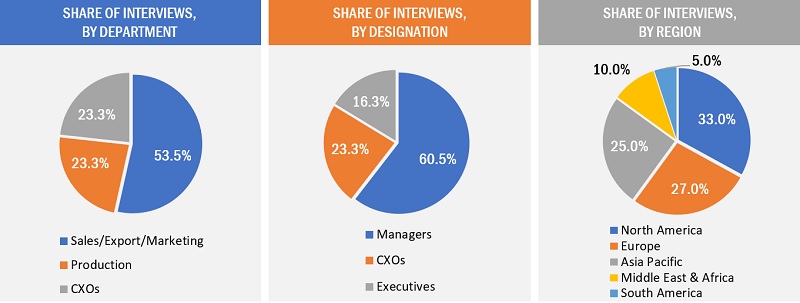
Notes: Other designations include product, sales, and marketing managers.
Tiers of the companies are classified based on their annual revenues as of 2021, Tier 1 = >USD 5 Billion, Tier 2 = USD 1 Billion to USD 5 Billion, and Tier 3= <USD 1 Billion.
To know about the assumptions considered for the study, download the pdf brochure
Market Size Estimation
Both top-down and bottom-up approaches were used to estimate and validate the size of the global Ceramic Tiles market. The research methodology used to estimate the market size includes the following:
- The key players in the industry were identified through extensive secondary research.
- The supply chain of the industry and market size, in terms of value, were determined through primary and secondary research.
- All percentage share split, and breakdowns were determined using secondary sources and verified through primary sources.
- All possible parameters that affect the markets covered in this research study were accounted for, viewed in extensive detail, verified through primary research, and analyzed to obtain the final quantitative and qualitative data.
- The research includes the study of reports, reviews, and newsletters of key industry players, along with extensive interviews with key officials, such as directors and marketing executives.
Market Size Estimation: Bottom-Up Approach and Top-Down Approach
Data Triangulation
After arriving at the total market size from the estimation process explained above, the overall market was split into several segments and subsegments. To complete the overall market size estimation process and arrive at the exact statistics for all segments and subsegments, data triangulation and market breakdown procedures have been employed, wherever applicable. The data have been triangulated by studying various factors and trends from both the demand and supply sides. In addition, the market size has been validated by using both the top-down and bottom-up approaches.
Market Definition
The Ceramic Tiles market refers to the industry that produces and supplies ceramic tiles. Ceramic tile material refers to a type of construction material that is made from clay, minerals, sand, and water. Ceramic Tiles are easy to durable, clean and maintain. These come in a variety of styles and patterns. They are used in both residential and non-residential works. Ceramic tiles can be used in different places like roofs, floors, walls, table tops, bathroom showers etc.
Key Stakeholders
- Raw material suppliers
- Ceramic tile manufacturers
- Ceramic tile importers and exporters
- Builders and contractors
- Government and research organizations
- Associations and industry bodies
- End users
Report Objectives
- To define, describe, and forecast the global Ceramic Tiles market in terms of value and volume.
- To provide insights regarding the significant factors influencing the growth of the market (drivers, restraints, opportunities, and challenges)
- To analyze and forecast the market based on type, application, region, and end-use sector.
- To forecast the market size, in terms of value and volume, with respect to six main regions: Asia Pacific, Europe, North America, Middle East & Africa, South America and Oceania
- To analyze the opportunities in the market for stakeholders and provide details of the competitive landscape
- To strategically profile key players in the market
- To analyze competitive developments in the market, such as new product launches, capacity expansions, and mergers & acquisitions
- To strategically profile the leading players and comprehensively analyze their key developments in the market
Available Customizations:
Along with the given market data, MarketsandMarkets offers customizations as per the specific needs of the companies. The following customization options are available for the report:
Product Analysis:
- Product Matrix, which gives a detailed comparison of the product portfolio of each company
Regional Analysis:
- Further breakdown of the Rest of the Asia Pacific Ceramic Tiles market
- Further breakdown of the Rest of Europe's Ceramic Tiles market
Company Information:
- Detailed analysis and profiling of additional market players (up to 5)



 Generating Response ...
Generating Response ...







Growth opportunities and latent adjacency in Ceramic Tiles Market